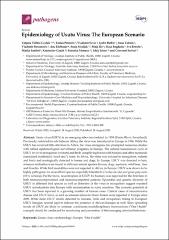Epidemiology of Usutu Virus: The European Scenario

View/
Date
2020Author
Vilibic-Cavlek, Tatjana
Petrović, Tamaš
Savić, Vladimir
Barbić, Ljubo
Tabain, irena
Stevanović, Vladimir
Klobučar, Ana
Mrzljak, Anna
Ilić, Maja
Bogdanić, Maja
Benvin, Iva
Santini, Marija
Capak, Krunoslav
Monaco, Federica
Listes, Eddy
Savini, Giovanni
Metadata
Show full item recordAbstract
Usutu virus (USUV) is an emerging arbovirus isolated in 1959 (Usutu River, Swaziland).
Previously restricted to sub-Saharan Africa, the virus was introduced in Europe in 1996. While the
USUV has received little attention in Africa, the virus emergence has prompted numerous studies
with robust epidemiological surveillance programs in Europe. The natural transmission cycle of
USUV involves mosquitoes (vectors) and birds (amplifying hosts) with humans and other mammals
considered incidental (“dead-end”) hosts. In Africa, the virus was isolated in mosquitoes, rodents
and birds and serologically detected in horses and dogs. In Europe, USUV was detected in bats,
whereas antibodies were found in different animal species (horses, dogs, squirrels, wild boar, deer
and lizards). While bird mortalities were not reported in Africa, in Europe USUV was shown to be
highly pathogenic for several bird species, especially blackbirds (Turdus merula) and great gray owls
(Strix nebulosa). Furthermore, neurotropism of USUV for humans was reported for the first time in
both immunocompromised and immunocompetent patients. Epizootics and genetic diversity of
USUV in different bird species as well as detection of the virus in mosquitoes suggest repeated
USUV introductions into Europe with endemization in some countries. The zoonotic potential of
USUV has been reported in a growing number of human cases. Clinical cases of neuroinvasive
disease and USUV fever, as well as seroconversion in blood donors were reported in Europe since
2009. While most USUV strains detected in humans, birds and mosquitoes belong to European
USUV lineages, several reports indicate the presence of African lineages as well. Since spreading
trends of USUV are likely to continue, continuous multidisciplinary interventions (“One Health”
concept) should be conducted for monitoring and prevention of this emerging arboviral infection.
